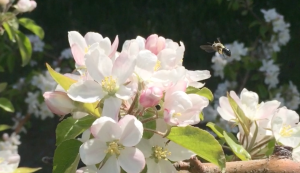 A new study from Cornell University, co-authored by Project ICP researcher Jason Gibbs (Michigan State University), finds that apple pollination in New York orchards is more related to diversity of wild bee communities than the abundance of honey bees. The authors observed and collected pollinators and measured seed set and pollen limitation in commercial apple orchards in western New York state. Seed set increased and pollen limitation decreased with increasing wild bee species richness, functional group diversity (based on nesting, sociality, and size traits), and abundance, but not with honey bee abundance.
A new study from Cornell University, co-authored by Project ICP researcher Jason Gibbs (Michigan State University), finds that apple pollination in New York orchards is more related to diversity of wild bee communities than the abundance of honey bees. The authors observed and collected pollinators and measured seed set and pollen limitation in commercial apple orchards in western New York state. Seed set increased and pollen limitation decreased with increasing wild bee species richness, functional group diversity (based on nesting, sociality, and size traits), and abundance, but not with honey bee abundance.
Functional group diversity of wild bees explained more variation in apple seed set than wild bee species richness, with big increases in seed set as the number of functional groups (for example, different nesting groups, such as ground-nesting and stem-nesting bees) at a site increases. “Management of diverse pollinator communities may decrease reliance on managed honey bees for pollination services and enhance crop yields,” the authors write. The authors suggest several ways that apple growers can actively maintain wild bee species richness and functional diversity in their orchards:
- Maintain diverse floral resources in and around orchards
- Develop strategies for enhancing ground-nesting bee habitat (e.g. tilling small patches of bare ground to 30cm depth)
- Install trap nests to encourage nesting by stem-nesting bees
- Maintain wood piles and abandoned stone walls as nest sites for cavity-nesting bumble bees
The original article, published in Agriculture, Ecosystems, & Environment, can be found here: http://www.sciencedirect.com.ezproxy.uvm.edu/science/article/pii/S0167880916300020.